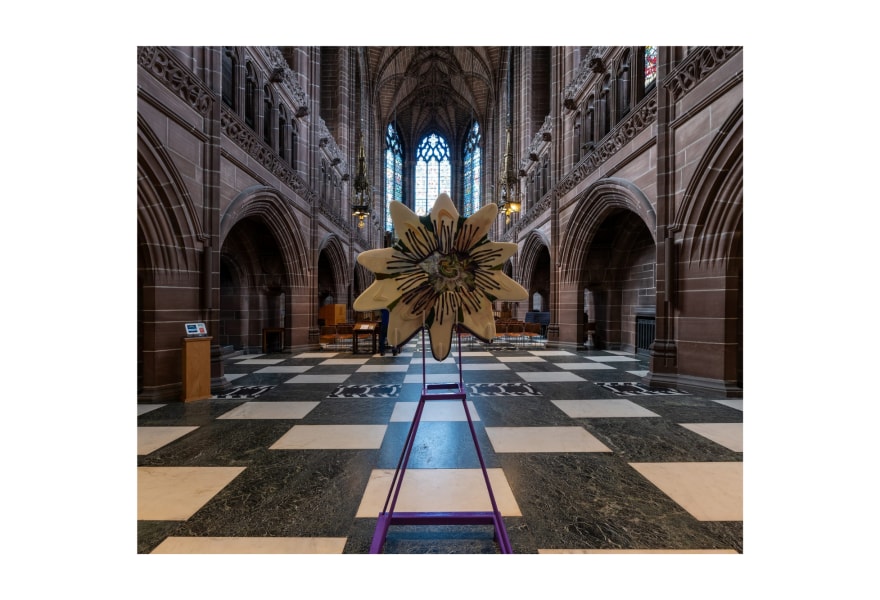24 june 2025, Flor Linckens
Three highlights from the Liverpool Biennial
If you’re planning a city trip this summer, consider Liverpool. Not just for The Beatles or the iconic dockside architecture, but especially for the renowned Liverpool Biennial: the UK’s largest free festival of contemporary visual art. Until 14 September 2025, you can discover work by thirty international artists and collectives at over twenty locations across the city. These installations, performances and exhibitions engage in striking ways with the past, present and future – the very fabric – of this former port city. All works are freely accessible, within walking distance, and can be found in everything from historic buildings to public spaces. Perfect for anyone looking to experience art and city in a single movement.
The thirteenth edition of the Liverpool Biennial is titled 'BEDROCK' and curated by Marie-Anne McQuay. Once again, the city plays a leading role. The theme refers not only to the sandstone on which Liverpool is built but also to the cultural and social foundations that shape its identity. Migration, colonial legacies, family ties, folklore, community and healing are just some of the themes explored by the participating artists, from diverse range of perspectives. Even football rivalries are addressed. Among the participating artists are three whose work is represented on GalleryViewer: Ana Navas (tegenboschvanvreden), Cevdet Erek (AKINCI) and Jennifer Tee (Galerie Fons Welters).
Ana Navas was born in Quito in Equador. She spent her childhood in Caracas and is now based in the Netherlands. She studied at the Staatliche Akademie der Bildenden Künste in Karlsruhe, followed by residencies at De Ateliers in Amsterdam, the Goethe-Institut in Salvador de Bahía and the Cité Internationale des Arts in Paris. She has received several accolades including the NN Art Award and the Illy SustainArt Award (ARCOmadrid), and has exhibited widely across Europe and Latin America, including recent presentations at the Oude Kerk and the Stedelijk Museum in Amsterdam.
Navas explores how objects and images change in meaning over time and how both personal and cultural context influence our perception of them. She notes how we tend to project familiar meanings onto unfamiliar forms, in an attempt to make sense of what we see. Positioned at the intersection of design, art and popular culture, her investigative practice invites new connections and interpretations. In the Lady Chapel of the stunning Liverpool Cathedral, she presents a series of fragile yet layered glass collages: figurative compositions that hover between abstraction and recognition. They echo the colour schemes and iconography of stained glass and historical portraits of women. Within the setting of the cathedral, the works take on a translucent, ghostlike corporeality. Another piece, made from glass and textile, is inspired by the embroidery of Liverpool women across generations, held in the cathedral’s archive.
Cevdet Erek was born in Istanbul in 1974, where he also lives and works. He studied architecture at the Mimar Sinan University of Fine Arts and went on to specialise in Sound Engineering, Design and Music at the MIAM institute of Istanbul Technical University (ITU). That intriguing combination of disciplines is clearly reflected in his practice. Erek creates multidisciplinary installations that merge sound, architecture and rhythm, often responding to the specific site in which they are shown. At Hamburger Bahnhof in Berlin, he built a sound installation for the Pergamon Altar. At the Venice Biennale, he presented a piece in which voices and memory took centre stage. In his "Rulers and Rhythm Studies", Erek examines rhythm not only as a musical element but as something bodily, historical and spatial. His work has also been shown at the Stedelijk Museum, documenta 13 and Spike Island in Bristol.
At 20 Jordan Street, Erek explores football culture as both a social and architectural phenomenon. His new installation "Away Terrace (Us and Them)" is built from compressed blocks from natural materials and references the physical separation between home and away stands in stadiums, as well as their atmosphere and aesthetics. Through layers of rhythmic sound (opposing sonic forces that press against each other) Erek questions how group identity, exclusion and power structures are materially embedded in public space. During the Liverpool Biennial, he also presents a stadium triptych in the Walker Art Gallery, exploring the deep-rooted rivalry between football clubs Liverpool and Everton. What do such loyalties reveal about family ties, identity, political structures, neighbourhoods, class, ethnicity or religion? Do they create pride and solidarity, or deepen division and exclusion?
Jennifer Tee was born in Amsterdam in 1973. She studied at the Gerrit Rietveld Academie and the Sandberg Instituut, followed by a residency at the prestigious Rijksakademie van Beeldende Kunsten. Her work has been shown at the Stedelijk Museum, the Rijksmuseum, Camden Arts Centre, Kunsthal Charlottenborg, the Van Abbemuseum, Frankfurter Kunstverein and the São Paulo Biennial.
Tee’s practice centres on the question of how to give form to the intangible. Working at the intersection of matter and spirit, she uses material experimentation and performative gestures to evoke abstract ideas such as the inner journey. Her work is both conceptually layered and materially rich, combining pressed tulip petal collages with knitted floor pieces, ceramic sculptures and textile forms. Sometimes, she integrates performance to amplify the fragile interconnection between body, space and existence. Recurring themes include identity, cultural hybridity, language and the exchange between people, nature and goods.
At the Walker Art Gallery, Tee presents three pieces from her ongoing "Tampan Tulips" series, in which she weaves together her Dutch and Chinese-Indonesian heritage. Using tulip petals as building blocks, she creates geometric collages inspired by tampan cloths from the Lampung region in South Sumatra. Within her visual vocabulary, she explores symbols such as birds, turtles, trees and ships: motifs that speak to migration, ancestral knowledge and transience. Tee fuses personal family history with global trade routes and spiritual narratives, with Liverpool serving as a poignant stop along the way.



